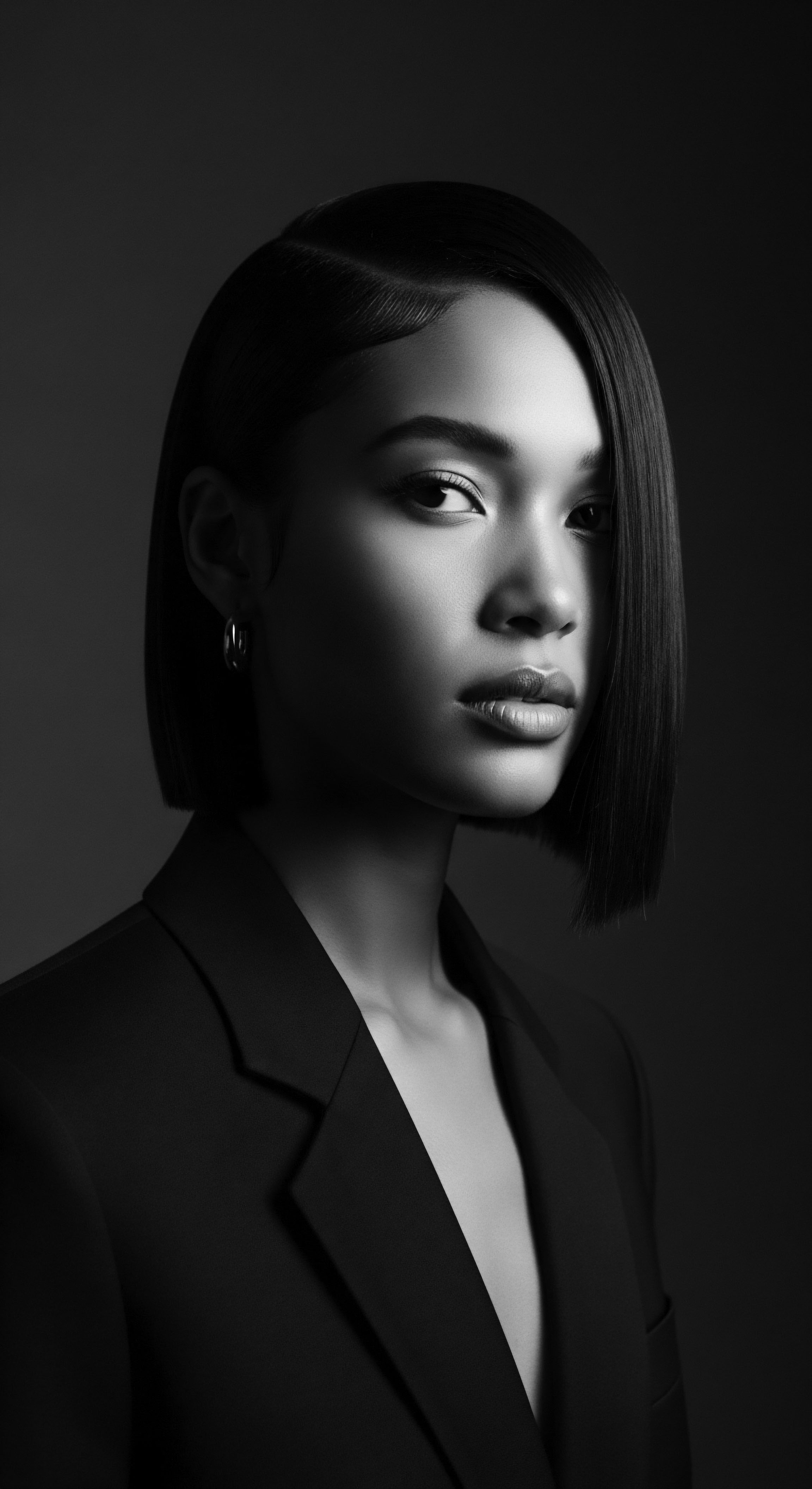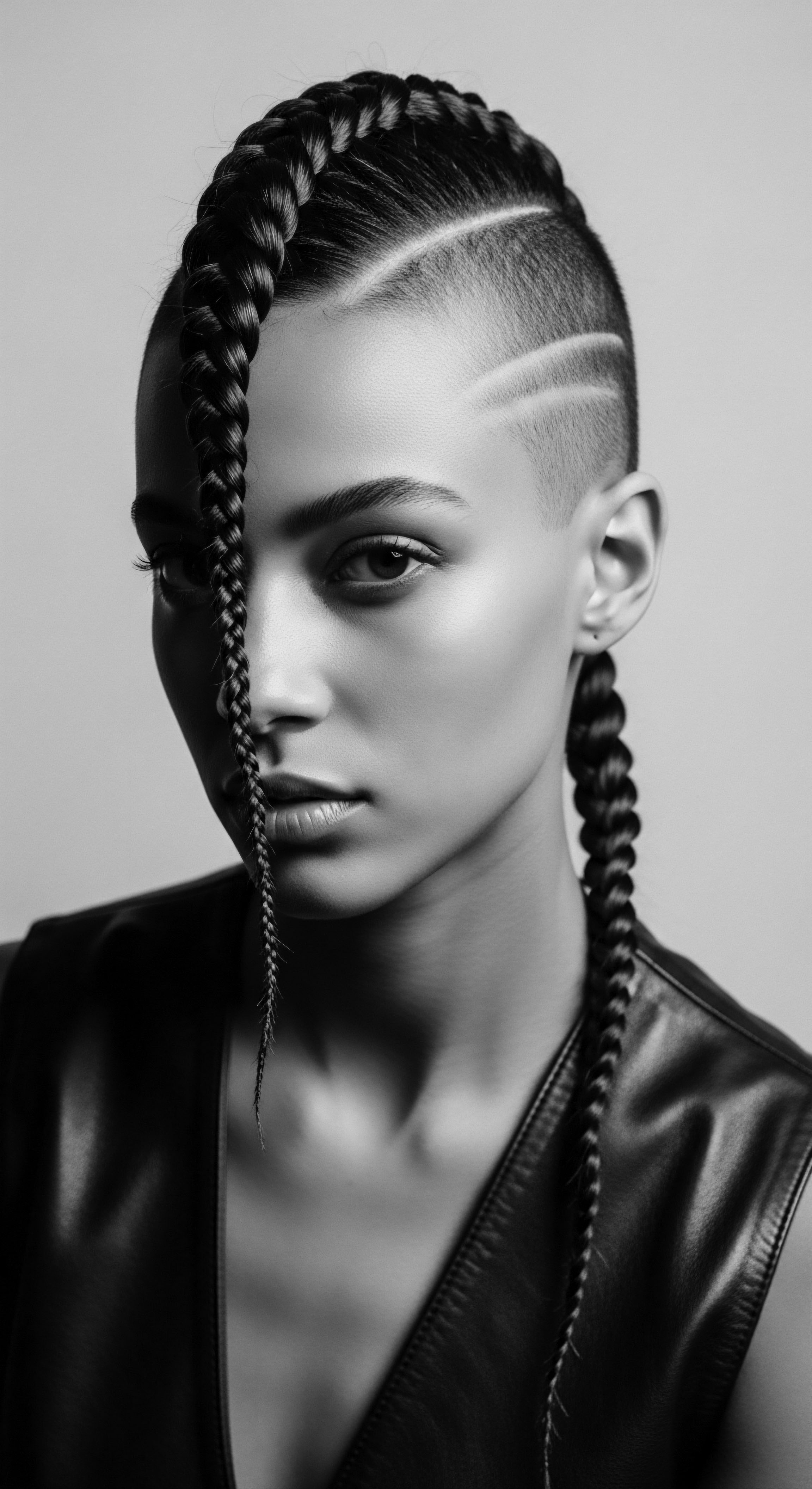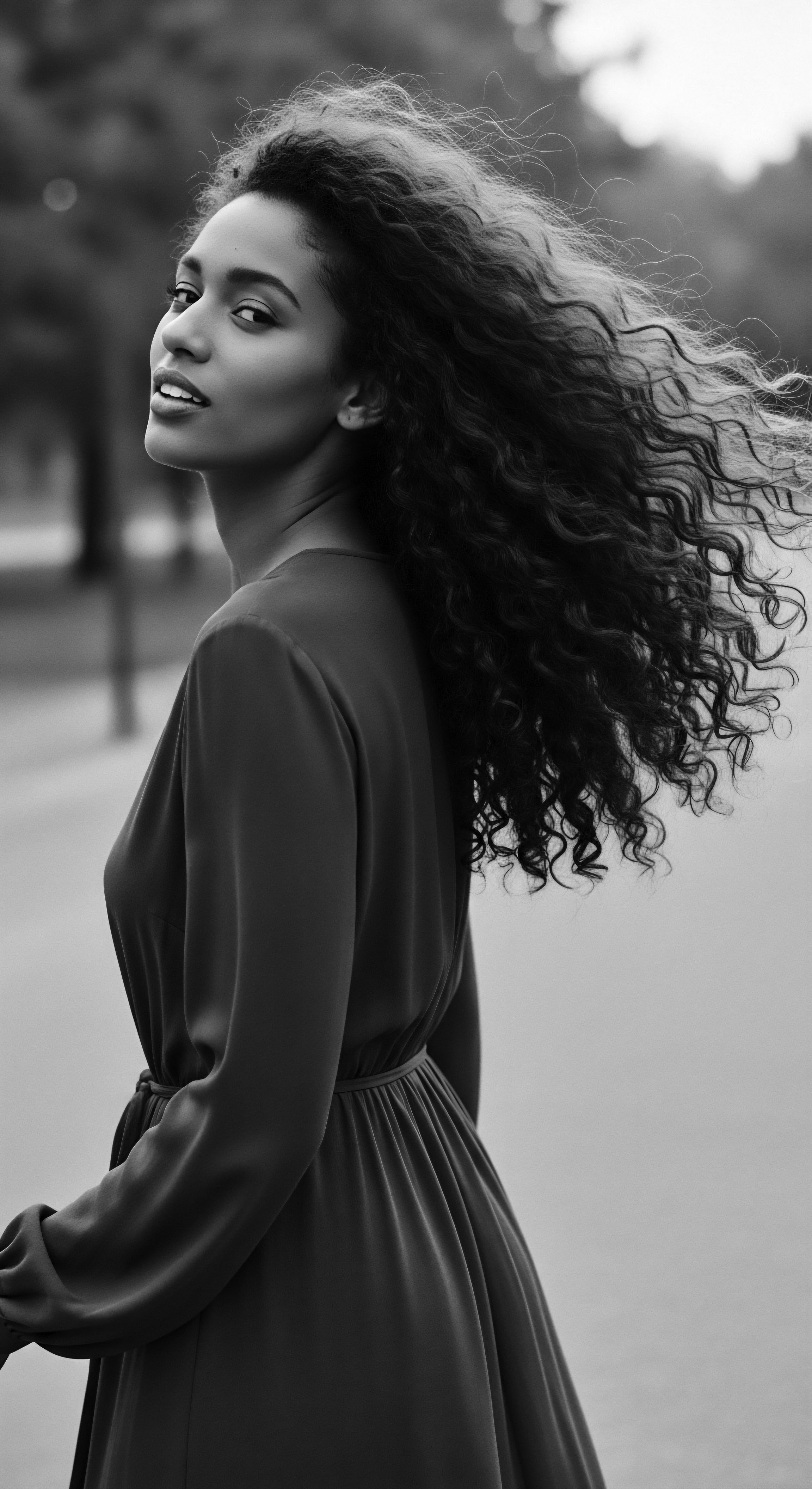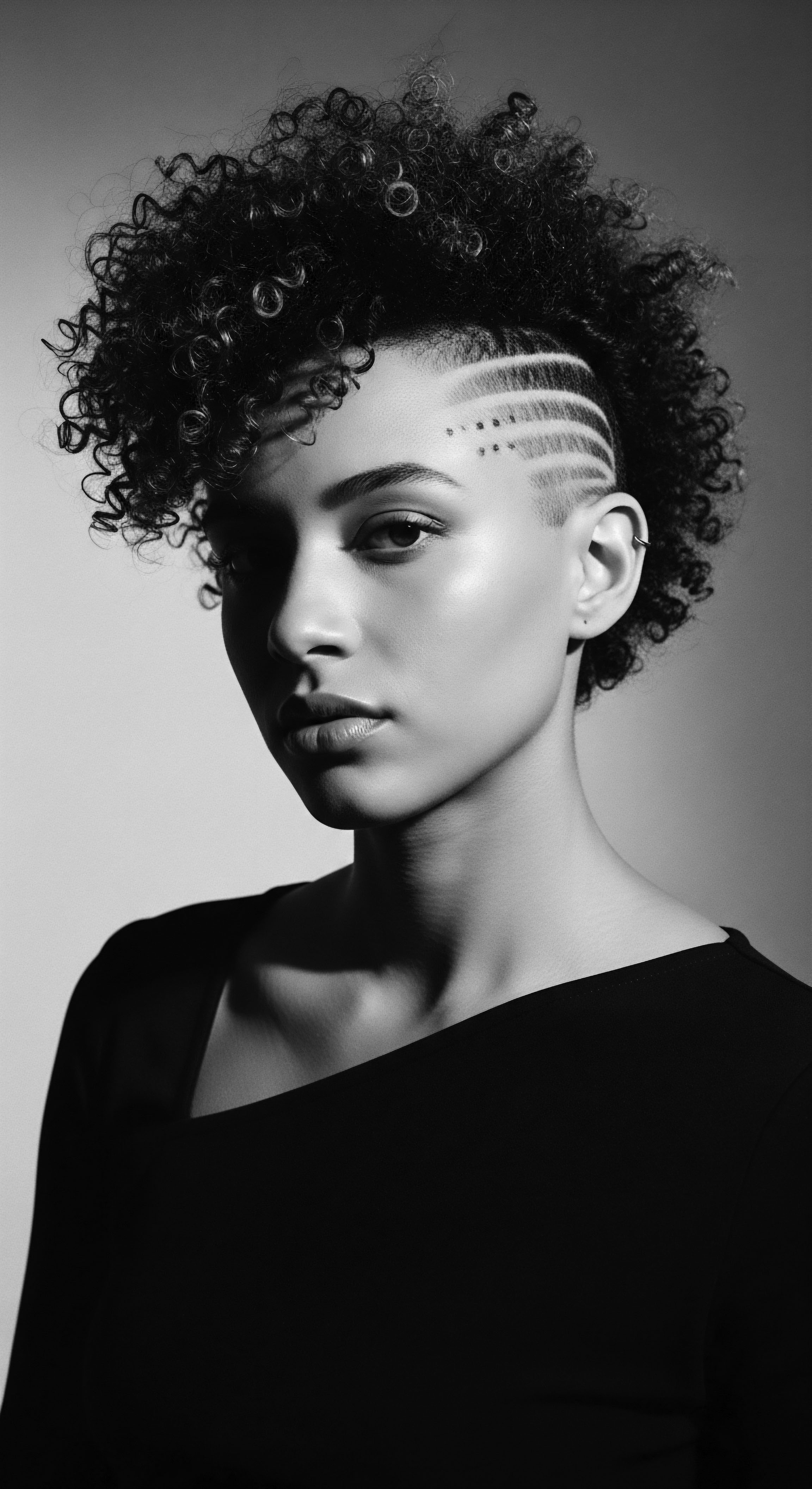
Fundamentals
The concept of Cultural Oil Blends extends far beyond a mere cosmetic application for textured hair. It represents an intertwining of botanical wisdom, ancestral practice, and communal well-being, deeply rooted in the heritage of Black and mixed-race communities across the globe. At its core, a Cultural Oil Blend is a carefully composed preparation, often passed down through generations, incorporating natural oils, herbs, and other elements chosen for their specific properties and symbolic meaning within a given cultural context. These blends are not haphazard concoctions; rather, they reflect a deep understanding of natural resources and their efficacy in nourishing and maintaining hair that defies Eurocentric ideals of straightness.
Consider a foundational understanding ❉ such blends are typically composed of carrier oils, which form the base, infused with active ingredients derived from plants, minerals, or even animal products, depending on the historical and geographical locale. The selection of these components is a deliberate act, drawing from a rich pharmacopoeia accumulated over centuries. The purpose behind these preparations extends beyond simple moisture or shine; it encompasses protection, healing, ritual, and a tangible connection to identity.

The Simple Meaning
In its most straightforward meaning, a Cultural Oil Blend is a mixture of natural emollients and botanicals applied to hair, especially textured hair, to support its health and beauty. The term ‘blend’ underscores the deliberate combination of various elements, each contributing to the overall efficacy and symbolic significance of the preparation. This practice, often termed ‘oiling’ or ‘oil bathing,’ has a venerable history stretching back millennia, with evidence of its widespread use in ancient African civilizations.
For instance, the tradition of oil baths for hair dates to ancient Egypt, where Queen Cleopatra reportedly anointed her body with oils, a practice subsequently adopted by others in the royal court. This historical precedent establishes the long-standing recognition of oils as essential components of beauty and hair care.
A Cultural Oil Blend is a deliberate fusion of natural elements, imbued with ancestral wisdom for the holistic care of textured hair.
The definition encompasses more than just the ingredients; it speaks to the ritualistic aspects of application. Often, these blends are applied with mindful intent, accompanied by massage and styling practices that further enhance their benefits. The sense of purpose behind these applications is to foster robust hair, protect it from environmental stressors, and maintain its inherent qualities. The clarification here is that these are not merely products; they are extensions of a holistic philosophy of self-care and communal connection.

Elemental Components and Their Early Uses
Early forms of Cultural Oil Blends were crafted from resources readily available in local environments. This included butters extracted from shea nuts, known as Shea Butter (Vitellaria paradoxa), which offered deep moisturization and protection, particularly in the arid climates of West Africa. Similarly, Coconut Oil, derived from the fruit of the coconut palm, provided hydration and a protective barrier. These base oils served as fundamental components, chosen for their inherent ability to coat and nourish the hair shaft.
Beyond simple oils, early practitioners understood the power of plant infusions. Leaves, barks, and roots with medicinal properties were often steeped in these carrier oils to impart additional benefits, such as soothing the scalp or promoting growth. This meticulous process of preparation was itself a ritual, a quiet act of devotion to the hair and its well-being. The interpretation of these practices reveals an innate scientific curiosity, observing and understanding the effects of different natural elements on hair health, long before formal chemical analysis existed.
- Shea Butter ❉ Extracted from the nuts of the shea tree, utilized for centuries across West Africa for its deep moisturizing and protective qualities, especially vital in harsh climates.
- Coconut Oil ❉ A versatile oil, widely used for its moisturizing properties, often applied to add shine and seal moisture within the hair strands.
- Palm Kernel Oil ❉ Sourced from the seeds of the oil palm tree, traditionally used by West African communities for scalp nourishment and hair growth.
The delineation of Cultural Oil Blends from simple oils lies in this thoughtful combination and the heritage embedded within each component. It is a statement of cultural ingenuity, transforming raw materials into sophisticated preparations for hair care.

Intermediate
Moving beyond the foundational understanding, a more intermediate apprehension of Cultural Oil Blends reveals them as profound expressions of cultural identity and communal wisdom within the tapestry of textured hair care. These blends are not isolated products but rather central elements within intricate systems of care, tradition, and self-expression that have persisted through centuries, often in the face of immense adversity. Their significance goes beyond superficial beauty, connecting individuals to collective histories and shared experiences across the African diaspora.
The true meaning of Cultural Oil Blends becomes clearer when one considers the multi-layered roles hair has played in African societies and among people of African descent. Hair served as a communicative medium, indicating age, social status, marital status, tribal affiliation, wealth, and even spiritual connection. Consequently, the care afforded to hair, including the application of specific oil blends, was never a trivial matter. It was a ritualistic endeavor, a tangible link to heritage, and a means of preserving cultural memory.

The Tender Thread ❉ Ritual and Community
The application of Cultural Oil Blends was frequently a communal activity, particularly among women. These moments transcended simple hair care, becoming opportunities for bonding, storytelling, and the intergenerational transfer of knowledge. In many African cultures, braiding hair often involved gatherings of mothers, daughters, and friends, strengthening social ties while simultaneously preserving cultural identity through shared rituals. The oil blends themselves were integral to these practices, used to soften hair, ease detangling, and impart a lustrous sheen.
Cultural Oil Blends are living archives of ancestral hair care, whispered through generations and celebrated in communal rites.
The significance of this communal aspect cannot be overstated. When enslaved Africans were brought to the Americas, their hair was often shaved, a brutal act intended to strip them of their identity and connection to their heritage. Yet, even in such dehumanizing circumstances, the practice of braiding persisted as a quiet act of resistance and cultural preservation.
Available fats and oils, rudimentary as they may have been, were repurposed to care for hair, maintaining a link to ancestral methods. This perseverance highlights the inherent resilience of these practices and the profound emotional and cultural meaning attached to hair care.
Take, for example, the Himba people of Namibia. Their use of Otjize, a paste created from butterfat, finely ground red ochre, and aromatic resins, stands as a vibrant case study of a Cultural Oil Blend deeply interwoven with identity. Applied daily to both skin and hair, otjize serves practical purposes like sun protection and insect repellent in their arid environment. However, its true essence lies in its symbolic weight, representing blood, the earth’s rich red color, and the very essence of life.
Himba women’s elaborate hairstyles, sculpted with otjize and often lengthened with goat hair, visually communicate their age, marital status, and social standing. The application of otjize, a daily ritual, is passed from mothers to daughters, cementing cultural continuity through tactile engagement with their heritage. This specific historical example vividly illustrates how Cultural Oil Blends were, and continue to be, far more than beauty products; they are carriers of identity, history, and communal bonds.

The Science Behind the Ancestral Touch
From an intermediate scientific vantage, the choice of ingredients in traditional Cultural Oil Blends often reflects an intuitive understanding of hair biology, even without modern scientific terminology. For instance, the use of various oils to moisturize textured hair is crucial because its coiled structure naturally impedes the even distribution of sebum, the scalp’s natural oil, from root to tip. This structural reality means textured hair tends to be drier and more susceptible to breakage without external hydration.
| Traditional Oil/Butter Shea Butter |
| Source Region West Africa |
| Key Properties & Traditional Uses Deep moisturizer, skin repair, anti-inflammatory. Used for centuries to soften hair and protect from harsh weather. |
| Modern Scientific Link (Where Applicable) Rich in vitamins A and E, providing emollients that seal in moisture and protect hair. |
| Traditional Oil/Butter Palm Kernel Oil (African Batana Oil) |
| Source Region West Africa |
| Key Properties & Traditional Uses Nourishes scalp, promotes healthy hair growth, combats dryness and dandruff. |
| Modern Scientific Link (Where Applicable) Contains lauric acid, vitamins A & E, and essential fatty acids that strengthen follicles and reduce thinning. |
| Traditional Oil/Butter Baobab Oil |
| Source Region Central & Southern Africa |
| Key Properties & Traditional Uses Moisturizing for skin and hair, improves elasticity, regenerates cells. |
| Modern Scientific Link (Where Applicable) High in essential fatty acids and vitamins A, D, and E, which support hair moisture and elasticity. |
| Traditional Oil/Butter Marula Oil |
| Source Region Southern Africa |
| Key Properties & Traditional Uses Rich in fatty acids and antioxidants, nutritive for skin and hair. |
| Modern Scientific Link (Where Applicable) Provides antioxidants and fatty acids, beneficial for dry hair formulations. |
| Traditional Oil/Butter These oils represent a profound understanding of natural remedies, passed through generations, for maintaining the vitality of textured hair. |
The ancestral choice of specific oils often aligns with their known chemical compositions:
- Jojoba Oil ❉ While originating in indigenous American cultures, its chemical similarity to human sebum made it a natural fit for Black hair care, particularly during the “Black is Beautiful” movement of the 1970s. Its use became an act of resistance against Eurocentric beauty ideals, reflecting a broader affirmation of cultural authenticity.
- Karkar Oil ❉ A traditional Somali blend of sesame oil, ostrich oil, cow fat, and honey wax, valued for promoting hair growth, reducing breakage, and improving overall hair and scalp health.
These formulations demonstrate a sophisticated, albeit empirically derived, understanding of what textured hair requires to flourish. The wisdom is not merely anecdotal; it is grounded in observed efficacy over countless generations.

Academic
The academic understanding of Cultural Oil Blends necessitates a comprehensive examination, moving beyond superficial definitions to explore their deeply embedded meaning, complex historical evolution, and profound socio-cultural significance. These preparations, far from being simplistic emollients, represent highly sophisticated systems of knowledge, resilience, and identity construction, particularly within Black and mixed-race communities. Their existence and persistence underscore a living heritage, a tangible link to ancestral practices, and an ongoing dialogue between traditional wisdom and contemporary scientific inquiry.
A Cultural Oil Blend is, therefore, a dynamic nexus where ethnobotanical expertise converges with dermatological needs and cultural affirmation, often serving as a conduit for preserving and transmitting communal narratives about beauty, struggle, and endurance. It functions as a declarative statement, an interpretation of care, a delineation of self, and a profound explication of cultural continuity.

Meaning and Interconnected Incidences in Textured Hair Heritage
The meaning of Cultural Oil Blends is multifaceted, encompassing nutritional, ritualistic, and resistive dimensions. From an academic perspective, these blends exemplify ethno-pharmacological ingenuity, demonstrating how diverse societies, lacking modern laboratories, developed highly effective topical applications for hair and scalp health. The active components, often derived from plants indigenous to specific regions, were selected based on observed effects—moisture retention, antifungal properties, tensile strength improvement—knowledge garnered through generations of empirical observation.
The significance of these practices extends into the realm of self-care as a political act. For individuals of African descent, whose natural hair textures have historically been marginalized or deemed “unprofessional” within Eurocentric beauty standards, the adherence to traditional oiling practices became a powerful act of reclaiming agency and affirming inherent beauty.
An interconnected incidence powerfully illustrating this concept is the enduring practice of hair oiling and styling among the Basara Women of Chad, particularly concerning their use of Chebe Powder. This tradition, dating back centuries, involves mixing Chebe powder (a blend of indigenous herbs, seeds, and plants) with oils or butters and applying it to damp, sectioned hair before braiding it for days. This ritual is passed down through generations, yielding exceptionally long, thick hair that often extends past the waist.
Cultural Oil Blends serve as powerful cultural markers, embodying centuries of resilience and self-determination through hair care.
The Basara women’s practice transcends mere aesthetics; it serves as a testament to profound length retention and hair health in challenging environmental conditions. Academically, this example offers a compelling counter-narrative to modern debates concerning the efficacy of raw oils and butters in hair care, which sometimes suggest they hinder water absorption or curl definition. While contemporary hair care discourse often emphasizes maximum curl definition through water absorption, the Basara method prioritizes length retention through protective styling and consistent application of their blend. This highlights a critical divergence in hair care philosophies ❉ while some modern approaches focus on visual curl aesthetics, traditional practices like the Basara method prioritize hair integrity and growth, proving that varying objectives necessitate distinct approaches.
The effectiveness of Chebe, combined with oils, in preventing breakage and maintaining moisture for type 4 hair textures is now recognized globally, reinforcing the deep, practical knowledge of ancestral practices. This is not simply a folk remedy; it represents a sophisticated, empirically validated system of care tailored to specific hair needs and environmental realities.

Historical Trajectories and Diasporic Adaptations
The historical trajectory of Cultural Oil Blends demonstrates remarkable adaptability and resilience. Prior to the transatlantic slave trade, intricate hair styling and oiling practices were central to African societies, communicating social status, age, and spiritual beliefs. Natural butters, herbs, and oils were staples for moisture retention.
The forced removal of Africans from their homelands during slavery included the deliberate shaving of heads, an act intended to strip individuals of their identity and cultural markers. Access to traditional tools and natural ingredients was severed.
Despite these systemic attempts at cultural erasure, the deep-seated knowledge of hair care, including the use of available fats and oils, persisted. Enslaved people found ingenious ways to adapt, utilizing whatever was at hand—bacon grease, butter, or kerosene in some instances—to cleanse and condition hair, maintaining aspects of traditional practices. Cornrows, for example, became a subtle act of resistance and a means of communication, with patterns potentially serving as maps for escape routes.
The development of “kitchen beauty shops” post-emancipation and the rise of Black beauty entrepreneurs like Madam C.J. Walker (though her methods initially emphasized straightening hair to conform to Eurocentric ideals) illustrate the continuing evolution and commercialization of Black hair care, always retaining a subtle connection to the foundational need for moisture and protective styling.
The contemporary Natural Hair Movement further underscores the enduring relevance of Cultural Oil Blends. This movement, gaining significant traction in the early 2000s and building on the “Black is Beautiful” ethos of the 1960s, represents a conscious return to embracing natural hair textures and traditional care practices. The renewed focus on natural oils like shea butter, castor oil, and specialized blends echoes ancestral wisdom, affirming hair health as an aspect of holistic well-being and a link to lineage.

Modern Intersections and Future Considerations
Modern scientific understanding increasingly validates the empirical wisdom of Cultural Oil Blends. Dermatological research acknowledges the unique structural characteristics of textured hair, emphasizing the need for moisture retention and protection against mechanical damage. The long-chain fatty acids present in many traditional oils, like those found in shea or palm kernel oil, form a protective barrier on the hair shaft, reducing water loss and increasing flexibility.
Contemporary formulations may refine these ancestral blends, incorporating modern extraction techniques or adding synergistic compounds, but the fundamental principles remain grounded in historical practices. The continued exploration of these blends requires a careful balance of honoring their cultural genesis while also leveraging scientific advancements to enhance their efficacy.
The global market for natural hair products, heavily influenced by the natural hair movement, reflects a growing appreciation for the efficacy of these traditional ingredients. This economic shift also presents a unique opportunity for communities whose ancestors originated these practices to benefit from the commercialization of their heritage. Ethical sourcing and equitable partnerships are crucial to ensure that the economic value generated by Cultural Oil Blends directly supports the communities that have preserved this knowledge for generations. This responsibility calls for a critical examination of how historical practices are re-contextualized and marketed in a globalized economy, ensuring that the essence and history of these blends are respected.
Future explorations of Cultural Oil Blends will likely continue to bridge the gap between tradition and innovation. Research into the specific biochemical properties of lesser-known indigenous botanicals, coupled with an understanding of their cultural applications, promises to yield further insights into effective and culturally resonant hair care. The continued communal practice of oiling, whether in a traditional village setting or a modern salon, serves as a vital reminder that hair care is a profound act of self-love, cultural affirmation, and connection to a rich, enduring heritage.
- Himba Otjize ❉ A blend of butterfat, ochre, and aromatic resins, used for both hair and skin protection and as a profound cultural identifier in Namibia.
- Chebe Powder ❉ A Chadian blend of herbs and seeds mixed with oils, applied to hair for exceptional length retention and moisture.
- Karkar Oil ❉ A traditional Somali mixture of sesame oil, ostrich oil, cow fat, and honey wax, prized for promoting hair growth and reducing breakage.
The continuous evolution of these blends and the renewed interest in ancestral practices highlight a significant movement towards holistic well-being, where external appearance is inextricably linked to internal validation and cultural pride. This deep connection ensures that Cultural Oil Blends remain far more than products; they are potent symbols of identity, resilience, and the enduring power of heritage.

Reflection on the Heritage of Cultural Oil Blends
The journey through the definition of Cultural Oil Blends ultimately leads us to a profound reflection on the enduring heritage of textured hair and its indelible connection to ancestral wisdom. These blends are not inert concoctions; they are living testaments to human ingenuity, resilience, and an unwavering commitment to self-definition through the intimate act of hair care. They echo the whispers of grandmothers and the quiet strength of communities that understood, long before scientific validation, the intricate needs of hair that coiled towards the sky or formed intricate patterns close to the scalp.
Each application of a Cultural Oil Blend is a moment of reconnection, a tender thread weaving the present to the past. It is in these rituals that the “Soul of a Strand” truly resides – the spirit of heritage, the resilience of identity, and the beauty born of a deep understanding of one’s own natural essence. The historical understanding of how these practices survived centuries of oppression, adapting and transforming across continents, speaks volumes about their inherent power and the profound bond between hair and self.
The knowledge contained within these blends represents a timeless legacy, reminding us that true beauty springs from self-acceptance and a reverence for our origins. The continuing interest in these practices signifies not just a trend, but a conscious movement towards reclaiming and celebrating the ancestral stories etched within each curl and coil.

References
- Mango Butterfull Cosmetics. (2022). What is the purpose of the oil bath?
- Cécred. (2025). Understanding Hair Oiling ❉ History, Benefits & More.
- Hair Care Practices from the Diaspora ❉ A Look at Africa, America, and Europe. (2025). Black Hair Scholars.
- The Guardian Nigeria News. (2022). Otjize ❉ The Red Beauty Miracle Of The Himba People.
- INFRINGE. (n.d.). Himba Hair Rituals.
- BeautyMatter. (2025). The Untold Story of Jojoba Oil in Black Beauty.
- Library of Congress. (n.d.). Heavy is the Head ❉ Evolution of African Hair in America from the 17th c. to the 20th c.
- Photography by Toine IJsseldijk. (n.d.). The Himba Tribe ❉ Otjize.
- Sweet Light Photos. (2021). It’s All About the Hair!
- Livara Natural Organics. (2023). Black History Month ❉ The Rich History of Our African Hair.
- Rothschild Safaris. (2023). THE HIMBA Namibia’s Fascinating People.
- Salford Students’ Union. (2024). The Remarkable History Behind Black Hairstyles.
- Dermatology. (2023). What Every Dermatologist Must Know About the History of Black Hair.
- Refinery29. (2021). The Evolution Of The Natural Hair Movement.
- African American Museum of Iowa. (n.d.). History of Hair.
- African American Registry. (n.d.). Black Hair Care and Its Culture, a story.
- Substack. (2025). Ancestral Hair Rituals to Nourish Your Hair and Soul.
- Reddit. (2021). No raw oils and butters vs. Traditional African hair care? ❉ r/Naturalhair.
- The Natural Beauty Workshop. (2011). Oils of Africa.
- 22 Ayur. (n.d.). The Ancient Natural Ways of Hair Care Across Continents.
- Africa Imports. (n.d.). Traditional African Secrets For Long And Healthy Hair.
- Dermatology. (2025). Historical Perspectives on Hair Care and Common Styling Practices in Black Women.
- Africa Imports. (n.d.). Karkar oil for hair.
- KhalidaNaturals. (n.d.). Pure West African Batana Oil (Palm Kernel Oil).
- African Beauty and Skincare ❉ A Deep Dive into History, Traditions, and Natural Ingredients. (2025). BeautyMatter.
- The History of Chebe Powder ❉ An Ancient African Hair Secret for Hair Growth. (2025). ChebeUSA.
- Wikipedia. (n.d.). African-American hair.
- GirlsOnTops. (2020). A Sacred Legacy ❉ On Black Hair And The Revolutionary Power of Self-Exp.
